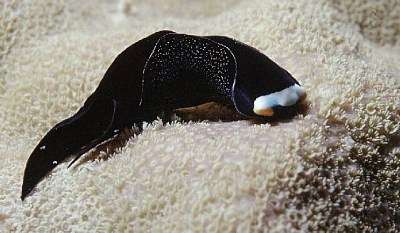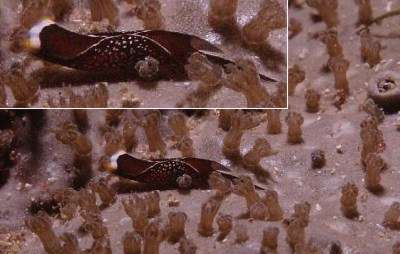feeding? observations - Chelidonura inornata
September 20, 1999
From: Erik Schloegl


Hi!
Here are two photos of Chelidonura inornata which might be considered interesting... The first photo is of what I assume is an adult (length approx. 4 to 5cm) on a hard coral, at Anderson Reef (Great Barrier Reef) November, 1998. The depth was 7m. There was a whole group of about a dozen of these animals on this particular coral colony, which was about 2m in diameter. I am pretty sure the C. inornata were feeding on the coral polyps, for the following reason: The animal in the photo moved slowly forward from polyp to polyp and it appeared to be grabbing each polyp and then rearing up about a third of its body length, as if ripping the polyp out of its "shell" - I'm now sorry I didn't capture that on film. Each time the C. inornata reared up, there was a quite audible crunching sound.
The second photo shows a tiny C. inornata (less than 1cm long) at a depth of about 15m on rocky bottom at Bowen Island (Jervis Bay, New South Wales). It is perhaps interesting in the sense that C. inornata is usually not found this far south - probably a juvenile washed south by the currents.
Regards,
Erik Schloegl
schloegl@maths.uts.edu.au
Dear Erik,
Thanks for the interesting observations on C. inornata.
If you've read the earlier messages on Chelidonura feeding you will see that the food of Chelidonura has been a bit of a mystery until recently. We have good evidence now to show they feed on flatworms. It is true that in popular books on coral reefs, species of Chelidonura are shown crawling over large coral colonies and at least one book actually states they feed on the coral mucus. I have long suspected they feed on small acoel flatworms which are often found in large numbers on coral, soft-coral and sponge colonies (see my June 1998 reply to Wayne Ellis. We now have observations that they do eat flatworms, so my theory is more plausible. (see message on trail following and the many messages on Chelidonura varians, where flatworm feeding observations are reported). The difficulty with them eating coral tissue is that they have no hard parts in their mouth - no jaw plates or teeth. Their foregut is also designed for suctorial feeding with a rigid, muscular buccal bulb much like the related genus Melanochlamys which feeds on polychaete worms.
It is possible that the 'rearing' behaviour you observed was either the Chelidonura being 'stung' by the coral's nematocycts, or it catching a commensal flatworm on the coral colony. The flatworms are small, up to 5mm long usually and similarly coloured to the animal colony they are living on. On the other hand you could be quite correct. It would be very strange, but perhaps they do eat coral tissue as well.
Now the size differences. Quite a few species of tropical Chelidonura are found at times in mid and southern New South Wales, and although adult (ie: mating and egg-laying) are usually much smaller than tropical animals. In August-September (early spring) there are often large numbers of Chelidonura fulvipunctata and also C. inornata at Long Reef, Sydney. The larvae wash down in currents from the tropical north. Why the animals in temperate waters are much smaller is a puzzle, with many species, the cold water animals are often much larger.
Thanks again for the intersting observations.
Bill Rudman.
Related messages
-
Chelidonura inornata feeding?
From: Leanne & David Atkinson, March 29, 2007 -
Re: Chelidonura inornata in sthn NSW
From: Francis Hawkshaw, March 15, 2006 -
Chelidonura inornata from sthn New South Wales
From: Francis Hawkshaw, March 13, 2006 -
Chelidonura inornata from Townsville, Australia
From: Paul Osmond, January 25, 2004 -
Chelidonura inornata from Line islands, Kiribati
From: Don Barclay, May 31, 2003 -
Chelidonura inornata from Lord Howe Island
From: W.B. Rudman, January 9, 2003 -
Chelidonura inornata from nthn New South Wales
From: John Pogonoski, August 16, 2002 -
Chelidonura inornata from the Line Islands
From: Cory Pittman, October 24, 2001 -
Chelidonura behaviour
From: Jeanette McInnes, October 10, 2001 -
Chelidonura inornata from Coral Sea
From: Des Paroz, October 19, 2000 -
Chelidonura inornata feeding?
From: Akos Lumnitzer, June 8, 2000 -
Chelidonura inornata - mating photo
From: Mary Jane Adams, January 30, 2000 -
Chelidonura inornata: mating & trail-following
From: M. J. Adams, January 25, 2000 -
Chelidonura from Mooloolaba
From: Wayne Ellis, June 20, 1998
